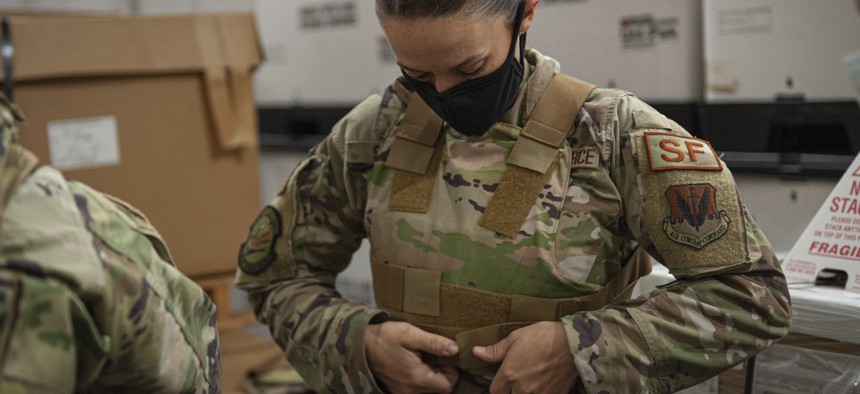
Tech. Sgt. Emily Souza, 23d Security Forces Squadron NCO in charge of combat arms, adjusts body armor Nov. 20, 2020, at Moody Air Force Base, Georgia. U.S. Air Force photo by Airman 1st Class Jasmine M. Barnes
To US Army, Getting Women’s Body Armor Quickly Is an Unfunded Priority
Lawmakers question why the service left $81 million to “accelerate” gear for women and short men out of its latest budget request.
Fielding better-fitting body armor for female and small-statured service members has long been on the Defense Department’s to-do list. Three years ago, female veterans in Congress introduced a bill to force the issue. On Monday, DOD leaders told Congress they now have the designs and enough money to start producing the gear—but the Army has requested another $81 million to accelerate the program by three years.
That request for extra funds to “accelerate” the modernization and fielding of the personal protective equipment—submitted as part of the Army’s “unfunded mandates” wish list of items left out of the president’s defense spending request—has prompted some lawmakers to question whether the Pentagon indeed had given body armor for women the right amount of money or attention they believe it still requires.
During a House Armed Services Subcommittee on Tactical Air and Land Forces hearing Monday on Army and Marine Corps ground systems modernization programs, Rep. Salud Carbajal, D-Calif., asked DOD leaders if President Joe Biden’s budget request for fiscal year 2022 included enough funds to “properly study and then procure” PPE for female soldiers and Marines.
“Absolutely,” answered Gen. John Murray, who leads Army Futures Command.
In the president’s budget request, the Army included $155 million in 2022 for better fitting body armor and extreme cold weather gear specifically for future Arctic operations, Defense News reported. The Biden administration's initial budget request documents do not show line item listings for body armor and “individual equipment” funds, the two accounts which cover things like helmets, bullet-proof plates and other gear. But according to last year’s Pentagon request, funding for body armor has fluctuated wildly. In 2019, the Army spent $245.4 million in total on body armor and $107.9 million for individual equipment. Those totals were expected to change significantly in 2020, to $176.8 million for body armor and $180.3 million for other PPE. In 2021, the Pentagon requested an increase to $234.6 million for body armor and a decrease to $127.2 million for PPE.
The Army did not immediately respond to requests for clarification on what funds in its $5.5 billion 2022 budget request would go towards small-stature body armor.
Progress to outfit women in the military has been slow. In June 2020, the Air Force’s Female Fitment Program Office awarded its first contract for improved female body armor. The branch started fielding the equipment one unit at a time by the end of last year. Provisions for female body armor were included in the 2021 National Defense Authorization Act, and the Army plans to roll out its modular scalable vest to small-stature soldiers with the 82nd Airborne later this summer.
Murray described the Army’s modern body armor for both women and small-stature male soldiers as “better produced and cut” to accommodate a “vastly expanded” range of sizes. The efforts to modernize PPE looked at specific undergarments, plate carriers, shooter’s cuts, and lightweight materials.
“The research and development at Natick is almost continuous,” Murray said, referring to the Army’s Natick Soldier Systems Center. “And then, as we make those breakthroughs, we roll that out into production to continually improve our protective material protection for our soldiers.”
Lt. Gen. Eric Smith, head of Marine Corps Combat Development Command and the deputy commandant for combat development and integration, told lawmakers the Marine Corps is “lockstep” with the Army in looking for the best, lightest body armor.
“We do have the money to do it. We have what we need,” Smith said.
But the slow pace will likely continue without more money.
Rep. Mikie Sherrill, D-N.J., asked why—if both the Army and Marine Corps believe they have the necessary funding—the Army’s unfunded priorities list requested another $81.7 million.
“The unfunded item is over and above what’s in the budget,” said Douglas Bush, acting assistant Army secretary for acquisition, logistics, and technology. “I believe the unfunded list refers to that as an opportunity to accelerate fielding.”
The Army’s unfunded list document says that without the extra funds, small-statured troops will continue using body armor that does not provide the maximum level of protection. It calls this risk “significant.”
“It just seems like this female body armor, small-stature body armor, is a critical funding piece,” said Sherrill, who served as a helicopter pilot in the Navy. “Having been in the military myself with gear that didn’t fit, not being able to fly over water during specifically cold months because my dry suit didn’t fit—this seems like a pretty critical piece of gear.”
Sherrill said that, in the face of the shift to great power competition against near-peers, the Army’s budget request for landmines seems less “imperative” than better-fitting body armor.
“I am curious about if you foresee the use of landmines in any sort of conflict with China in the future,” she said.
